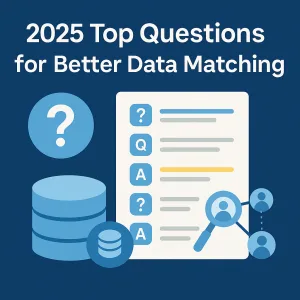2025 Top Questions for Better Data Matching

What is a data match?
A data match occurs when two or more records from different sources are identified as representing the same entity—such as a customer, company, or address. Matching helps organizations link related records even when their data entries are inconsistent. For example, “Jon Smith” in one list and “Jonathan Smith” in another can be recognized as the same person through similarity scoring.
How does data match work?
Data matching works by comparing selected fields—like name, email, address, or phone number—across datasets. These fields are analyzed for similarities using algorithms such as exact matching, fuzzy matching, or phonetic matching. When records meet the defined threshold for similarity, they’re marked as matches. Advanced platforms can also combine multiple rules (e.g., name + address) to increase accuracy.
What is an example of matching data?
A common example is in donor or customer databases. Suppose one list contains “Mary L. Johnson” at “123 Elm Street” and another has “M. Johnson” at “123 Elm St.” Traditional systems might treat them as different people, but a data matching engine identifies the similarities, calculates a high similarity score, and links them as one entity.
What is a data matching issue?
Data matching issues occur when errors—like inconsistent spelling, missing values, or incomplete fields—cause duplicate or missed matches. These problems often arise in large datasets collected over time from multiple systems. Poorly matched data can lead to inaccurate reports, redundant communications, or lost insights.
What is the meaning of data matching?
Data matching is the process of comparing datasets to find records that refer to the same real-world object. It’s a critical part of data quality management and entity resolution, ensuring information is consistent and unified across systems such as CRMs, marketing lists, or customer databases.
What is an example of matching data?
For example, a hospital might have “Dr. Robert T. White” listed in one system and “R. White” in another. By matching data based on name, specialty, and location, the records can be merged into a single, accurate profile. This prevents duplication and ensures accurate reporting.
How to do data matching?
Effective data matching begins with data profiling—analyzing the dataset to understand patterns and inconsistencies. Next, data cleansing standardizes fields by fixing formatting issues or errors. Then, match definitions and criteria are set, combining exact and fuzzy rules. Finally, a matching algorithm calculates similarity scores, groups records, and outputs linked results.
What is a data matching program?
A data matching program is software designed to automate the comparison and linking of records across data sources. These programs use advanced algorithms like Jaro-Winkler or cosine similarity to identify likely duplicates and group them. The best tools allow users to adjust thresholds, review matches, and merge records with confidence.
What are the benefits of data matching?
Data matching helps organizations eliminate duplicate records, improve accuracy, and unify fragmented information across systems. When implemented correctly, it ensures that decisions, reports, and analytics are based on complete and reliable data. It also improves customer communications, reduces wasted marketing costs, and enhances compliance by maintaining a single, consistent version of each entity.
What is the difference between data matching and data deduplication?
While both processes aim to improve data quality, data deduplication focuses on identifying and removing exact duplicates, whereas data matching identifies related records that may not be identical but refer to the same entity. For example, deduplication would remove two identical rows, while data matching might link “A. Johnson” and “Amy Johnson” as the same person even though the entries differ.
FAQs
What is a data match?
A data match identifies when two or more records from different sources refer to the same real-world entity—like a customer, company, or address. This process helps unify data scattered across systems, improving consistency and analytics accuracy.
How does data match work?
Data matching compares key fields—such as names, emails, or addresses—between datasets using algorithms like exact matching or fuzzy matching. When similarity scores meet a defined threshold, records are flagged as matches and can be merged or grouped.
What is an example of matching data?
If one database lists “Jon Smith” at “123 Elm Street” and another has “Jonathan Smith” at “123 Elm St.,” data matching detects the similarity and connects both entries as the same person.
What is a data matching issue?
Data matching issues arise from inconsistent formatting, missing values, or spelling variations. These errors can cause false duplicates or missed matches, leading to poor reporting and misinformed business decisions.
What is the meaning of data matching?
Data matching means comparing and linking related records to ensure a single, unified view of your data. It’s a key part of data quality management and entity resolution.
How to do data matching?
Start with profiling your data to detect inconsistencies, then cleanse and standardize the data. Define match rules (exact or fuzzy) and set thresholds for similarity. Finally, use a matching engine to calculate scores and group results.
What is a data matching program?
A data matching program is software that automates the process of comparing records, identifying duplicates, and grouping entities. It uses similarity algorithms and often provides scoring and merging options.
What are the benefits of data matching?
It eliminates duplicates, improves decision-making, and creates a single source of truth. Data matching also saves time and money by reducing manual review and ensuring accurate communications.
What is the difference between data matching and data deduplication?
Deduplication removes identical records, while data matching identifies similar but non-identical entries that represent the same entity. Matching goes beyond exact values to find connections others might miss.
Why is data matching important for organizations?
Accurate data matching ensures reliable analytics, clean marketing lists, better compliance, and improved customer experience. Without it, duplicated or fragmented data can damage reputation and operational efficiency.
